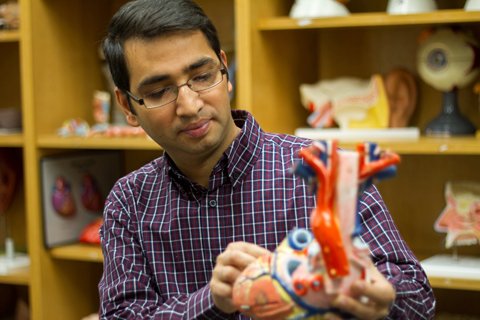Kandel and Roth Study the Electrical Properties of the Heart

Sunil Kandel, a 2015 graduate of the Biomedical Sciences: Medical Physics PhD Program, and CBR member Brad Roth, of the Department of Physics, published an article about The Mechanism of Reflection Type Reentry that appeared in the December 2015 issue of the Journal of Cardiovascular Electrophysiology (Volume 26, Pages 1370-1375). The publication represents one chapter in Kandel’s PhD dissertation; other chapters were published in Computational and Mathematical Methods in Medicine, the Circulation Journal, the Scholars Academic Journal of Biosciences, and the Journal of Nature and Science. Kandel has been nominated for the American Physical Society 2015 Award for Outstanding Doctoral Research in Biological Physics. He currently works as a post doc in the Department of Molecular and Integrative Physiology at the University of Michigan.
The abstract of Kandel’s recent paper in the Journal of Cardiovascular Electrophysiology is given below.
Introduction: Reflection is a special type of reentry in which an electrical wave front travels in a forward direction through tissue that is then re-excited by a wave front that propagates backward. This type of reentry has been studied computationally in 1-dimensional fibers and verified experimentally. Different hypotheses explaining reflected reentry have been proposed based on the structure and heterogeneity of the tissue properties, but the mechanism remains uncertain.Methods and Results: We used the bidomain model to represent cardiac tissue and the Luo-Rudy model to describe the active membrane properties. We consider an ischemic region in a volume of ventricular myocardium. Our results show that a slow depolarization in the ischemic border zone caused by electrotonic coupling to depolarized tissue in the normal region creates a delay between proximal and distal regions that produces enough electrotonic current in the distal region to re-excite the proximal region.
Conclusion: Our simulation shows that an early afterdepolarization (EAD) is not the source of the reflection. It depends on the pacing interval and stimulus strength necessary to maintain enough time delay between proximal and distal regions.
